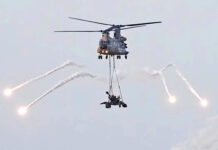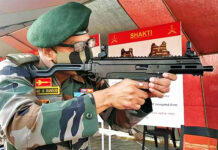The Defence Acquisition Council (DAC) gave its approval for procuring 106 Basic Trainer Aircraft (Hindustan Turbo Trainer-40) HTT-40 from Hindustan Aeronautics Limited (HAL) on 11 August to meet the basic training requirements of the Indian Air Force (IAF). This comes under the category of “Indian designed, developed and manufactured” (IDDM) equipment, as per the Defence Procurement Procedure of 2016. And the Basic Trainer has so far cleared all the Air Staff Qualitative Requirements (ASQR). Basic trainers figure on the government’s negative import list that seeks to ban the import of 101 different types of weapons, systems and ammunition over the next five years.
HAL has successfully developed BTA HTT-40 prototypes and certification process was underway. Initially post certification 70 Basic Trainer Aircraft will be procured and the balance 36 after operationalisation of HTT-40 fleet in IAF.
Spin Tests
This trainer has been designed and developed by HAL and is a basic fixed-wing aircraft. It will be equipped with Honeywell turboprop engine TPE-331-12B. In a span of five years, the HTT-40 has so far completed all the major spin tests.
In flight-testing, on 7 September 2019, in Bengaluru, HAL’s test pilots threw the HTT-40 into multiple spins and, each time, the trainer returned to level flight smoothly. In so doing, the HTT-40 cleared the so-called “six-turn spin test”, regarded as the ultimate and most difficult test for a trainer aircraft.
The HTT-40 has already met and, in many aspects of flight performance, surpassed the so-called “Air Staff Qualitative Requirements” (ASQRs), which lists out the flight performance — speed, turn, ceiling, etc. — that the IAF demands from an aircraft.
In November 2019, the chief of the IAF Air Chief Mshl RKS Bhadauria had taken the second prototype of HTT-40 basic trainer aircraft (TSR002) for a spin. In the flight which had lasted for almost one hour, the chief, who was accompanied by the HAL’s chief test pilot Gp Capt (Retd) KK Venugopal had assessed not only the stall and spin but also other flying characteristics of the aircraft.
ALSO READ IAF MODERNISATION: Tata Power SED to Modernise 37 Airfields
Earlier Opposition
Since 2012, the IAF had consistently opposed the HTT-40, first pressuring the MoD into importing 75 Pilatus PC-7 Mark II basic trainers from Switzerland, and then demanding more imports because HAL would allegedly never be able to steer the HTT-40 through all its tests.
“There is no need for [the HTT-40 trainer]”, then IAF boss, Air Chief Marshal NAK Browne, had dismissively stated at the Aero India show in 2013. “We have the Pilatus PC-7. It’s a proven aircraft. The project HAL plans is from scratch. Our indications are that the cost will be too high. There is no need for all this.” Each successive IAF chief followed the same line, criticizing the HTT-40, while demanding more Pilatus imports.
Successive HAL chiefs backed the HTT-40, committing Rs 350 crore of internal HAL funds to the project.
Pilatus Barred
The defence ministry in July 2019 suspended business dealings with Swiss plane maker Pilatus Aircraft Limited for one year for violation of a pre-contract integrity pact in a Rs 2,900-crore contract for 75 basic trainers, and also factoring in Indian investigations against the plane maker for alleged corruption and irregularities. The contract with Pilatus included a clause for follow-on purchase of 38 more planes.
Training Stages
Rookie pilots in IAF go through a three-stage training involving the Pilatus PC-7 MkII planes, Kiran trainers and finally the Hawk advanced jet trainers before they can fly fighter jets. As the Kirans are approaching the end of their service life, some amount of Stage 2 training is being done on the PC-7.
ALSO READ IAF MODERNISATION: Arming to be Ready
About HTT-40
HTT-40 is a new basic training aircraft being developed by Hindustan Aeronautics Limited (HAL) for the Indian Air Force (IAF). The new aircraft will replace the ageing fleet of HAL HPT-32 Deepak trainers that are in service with the IAF.
The aircraft will be primarily used for basic flight training, aerobatics, instrument flying and close-formation flights, whereas its secondary roles will include navigation and night-flying.
The first prototype of HTT-40 Trainer was rolled out from the Aircraft Research and Design Centre (ARDC) hangar, in February 2016.
The HTT-40 trainer made its first flight in May 2016.
The HTT-40 is a fixed-wing aircraft incorporating an all-metal airframe design. It features a bubble canopy, T-tail configuration and a retractable tricycle landing gear system with a steerable nose wheel.
The HTT-40 project was conceptualised by HAL to fulfil the IAF’s requirement of 181 trainer aircraft. Due to the HTT-40’s development delays, the air force placed an order in May 2012 for 75 Pilatus PC-7 Mk II turboprop trainers to meet its urgent operational requirements.
The MoD chose to procure 38 Pilatus trainers to replace its old trainer aircraft fleet in February 2015, while the remaining 68 aircraft will be sourced from HAL.
HAL completed works on ground test air-frame and also produced several air-frame structures for the first aircraft by mid-2015. The aircraft is projected to enter production by 2018. The serial production will start at HAL’s transport aircraft division (TAD) in Kanpur, India.
The air-conditioned, glass cockpit accommodates two crew, including an instructor and trainee in tandem seating configuration with zero-zero ejection seats. It integrates multi-function displays, and modern navigation and communication systems.
In June 2015, Honeywell was selected by HAL to supply the TPE331-12B turboprop engines for the high-performance HTT-40 military trainer aircraft. The TPE331-12B turboprop engine, equipped with full-authority digital engine control (FADEC) system, develops a maximum power output of 950 shaft horsepower (shp).
It is one of the most widely-employed turboprop power-plants in operation. It enables the HTT-40 to offer users quick acceleration, low-fuel consumption, high-reliability and the flexibility to conduct a range of training missions. The reliable turboprop engine also allows HAL to develop a range of variants that will deliver increased levels of performance.
Honeywell has delivered more than 13,000 TPE331 engines to both military and civil operators worldwide. The fleet of TPE331 engines accumulated more than 122 million flight hours to date. The engines power a range of aircraft, including light aircraft and advanced unmanned aerial vehicles (UAVs).
The HTT-40 trainer offers the best-in-class fuel economy and power rating. It takes-off from a short distance and has a high rate of climb. It has a maximum speed of 450km/h and can reach a maximum distance of 1,000km. The stall speed with flaps down is 135km/h.
The certified operational ceiling of the trainer is 6,000m, the ‘G’ limits are +6/-3 and airborne endurance is three hours.
Comments
While it’s a thumbs-up for the design and development of the HTT-40, HAL has to rise to the occasion now and produce them to a time schedule that the IAF wants.
The HTT-40 aircraft has undergone a string of elaborate tests at HAL to demonstrate that it is safe for rookie pilots and meets the IAF’s exacting standards for trainer planes. HAL could begin the production of the trainers by early next year.
HAL has manufactured the IAF’s fleet of Hawk advanced jet trainers (AJT), with technology from BAE Systems. With the HTT-40 poised for final clearance, a breakthrough on the IJT could mean that the IAF’s entire training aircraft fleet comprises of HAL-built aircraft.



















